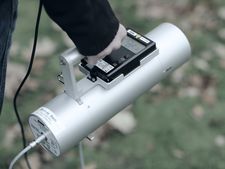-
Topics
subnavigation
Topics
Electromagnetic fields
- What are electromagnetic fields?
- Static and low-frequency fields
- Radiation protection relating to the expansion of the national grid
- High-frequency fields
- Radiation protection in mobile communication
Optical radiation
Ionising radiation
- What is ionising radiation?
- Radioactivity in the environment
- Applications in medicine
- Applications in daily life and in technology
- Effects
- What are the effects of radiation?
- Effects of selected radioactive materials
- Consequences of a radiation accident
- Cancer and leukaemia
- Genetic radiation effects
- Individual radiosensitivity
- Epidemiology of radiation-induced diseases
- Ionising radiation: positive effects?
- Risk estimation and assessment
- Radiation protection
- Nuclear accident management
- Service offers
-
The BfS
subnavigation
The BfS
- About us
- Science and research
- Laws and regulations
- BfS Topics in the Bundestag
- Links
BfS staff members contribute to investigation into increased ruthenium levels
Radiation protection authority sends experts to Russian investigating commission
Year of issue 2018
Date 2018.01.22
Date 2018.01.22
Staff members of the Federal Office for Radiation Protection (BfS) have supported the Nuclear Safety Institute of the Russian Academy of Sciences (IBRAE) in the investigatin of elevated ruthenium 106 levels, which were measured in large parts of Europe at the end of September 2017. An International Commission of Inquiry has been set up to find out the reasons of the elevated radiation levels. For this purpose, it is intended to review existing environ-mental measurement data and dispersion calculations and carry out further investigations, if necessary. The Commission is made up of renowned scientists in the field of radiation protection, includ-ing two BfS staff members.
BfS had reported on elevated levels of ruthenium 106 detected in Germany already at the beginning of October and was invited by the Russian colleagues to participate in the clarification of the facts. "It is a special appreciation of the BfS's work that our experts should contribute to the clarification of the elevated ruthenium levels"
, emphasized BfS President Inge Paulini. "The fact is that there was no health risk to the population at any time in Germany. Nevertheless, we have a great interest to find out the source of the ruthenium."
BfS will provide expertise
Florian Gering, head of the department "Radiological situation report" of BfS and Thomas Hamburger will represent the BfS in the Commission. "The aim is to provide the Russian colleagues with the expertise that BfS has already demonstrated in the confinement of the place of origin. In addition, BfS also has measuring technology that could be used for on site reconnaissance"
, explained Gering. This could include, among others, special measuring instruments that can be used by helicopters to provide more detailed information on possible contamination in certain areas. The operation of such flights to measure radioactive material deposited on the ground is regularly trained in cooperation between BfS and the Federal Police.
At the end of September 2017, slightly elevated radioactivity concentrations in the air were detected at various trace stations in Europe. Small quantities of ruthenium-106 were measured at a total of seven stations in Germany and at numerous stations in other European countries (including Austria and Italy). The concentration of the radioactive material in Germany was low, ranging from a few microbecquerels to a few millibecquerels per cubic meter.
BfS calculations on the propagation of radioactive substances in the atmosphere indicated an origin in the southern Urals, and a place of origin in southern Russia could not be ruled out in the near future. However, data from the Russian weather service Roshydromet dated end of November suggest that areas west and south of the Urals are out of the question due to the prevailing wind direction at that time. The French Radiation Protection Authority IRSN (Institut de Radioprotection et de Sûreté Nucléaire) came to similar conclusions after a professional exchange with the BfS. Since only ruthenium-106 was detected, an accident in a nuclear power plant can be excluded as the cause.
Background information on Ruthenium-106
Ruthenium-106 is a beta emitter, and its daughter nuclide Rhodium-106 is a very short-lived gamma emitter, so that beta and gamma rays always occur together during the decay of ruthenium-106. Ruthenium-106 has a half-life of slightly more than one year (372 days). Ruthenium-106 is a fission product occurring during the fission of uranium in a nuclear power plant.
Ruthenium-106 is used, among others, as a radiation source for cancer therapy in the treatment of eye tumours. In addition, ruthenium-106 is rarely applied in Radioisotope Thermoelectric Generators (RTG), which are used to power satellites. Ruthenium can also occur in the reprocessing of nuclear fuel assemblies.
State of 2018.01.22




